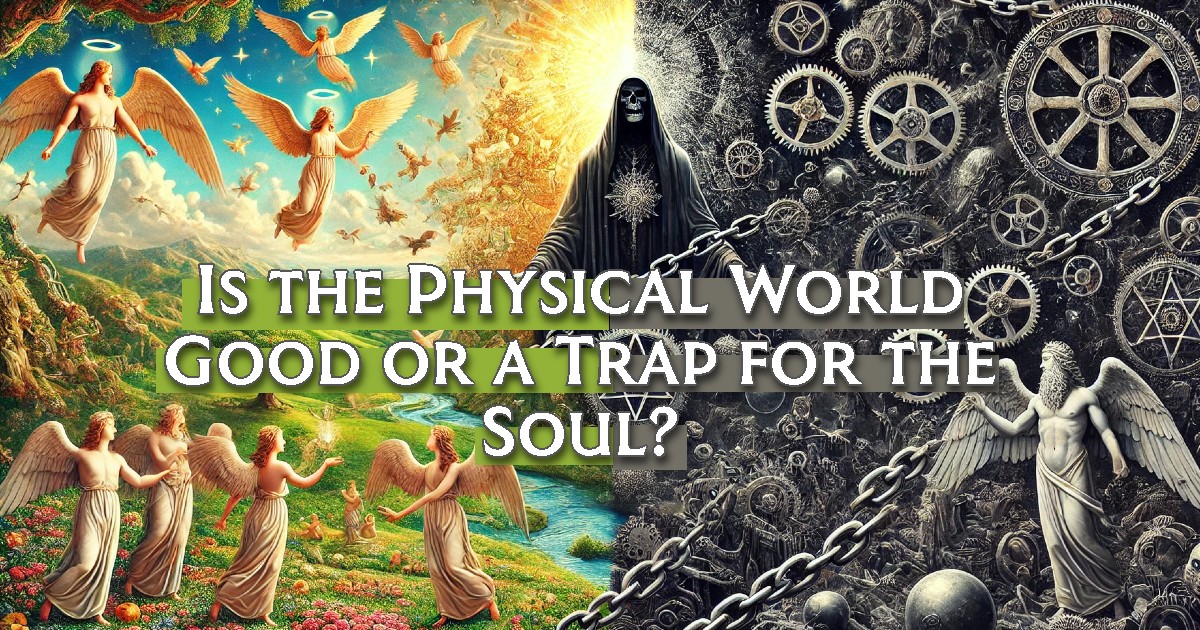Throughout history, philosophers, theologians, and mystics have debated the true nature of our physical reality. Is the world we experience a divine gift, designed for growth and fulfillment? Or is it a prison—an illusion meant to keep us bound to suffering and ignorance? This question has shaped religious traditions, influenced spiritual seekers, and remains just as relevant today as it was in ancient times.
The Traditional View: A Divine Creation
Many religious traditions, especially within mainstream Christianity, Judaism, and Islam, regard the physical world as a purposeful and good creation. In the biblical Book of Genesis, God sees everything He has made and declares it “very good.” The natural world, in this view, is not a prison but a stage for human experience—where we learn, love, and develop spiritually.
For these traditions, the material world is not inherently evil. Instead, it is human choices—greed, violence, and selfishness—that introduce suffering. The path to salvation or enlightenment, then, is not escaping the world but transforming ourselves within it.
The Alternative View: A Cosmic Illusion
In contrast, certain ancient traditions, especially Gnosticism, some branches of Hinduism and Buddhism, and even elements of modern spiritual thought, argue that the physical world is not what it seems. The Gnostics, for example, believed that an imperfect or even malevolent deity, the Demiurge, created the material universe to trap divine sparks—our souls—within it.
From this perspective, the physical world is filled with suffering and deception, keeping us distracted from our true spiritual nature. Attachments to material wealth, bodily pleasures, and even societal expectations are seen as chains that bind the soul. True liberation, according to Gnostic and similar teachings, comes from awakening to this reality and seeking higher knowledge—gnosis—that allows one to escape the illusion.
Science and Modern Philosophy: A Middle Ground?
Science does not typically concern itself with the “good” or “evil” of the material world but instead seeks to understand it. However, certain scientific and philosophical perspectives echo the ancient idea that reality is not as solid as it appears. Quantum physics, for example, suggests that what we perceive as “physical” may be more of an energetic or informational construct than a fixed reality.
Some modern thinkers suggest that our attachment to the material world—especially in consumer-driven societies—functions as a form of imprisonment. We are often caught in cycles of desire, consumption, and dissatisfaction, leading to a kind of existential entrapment. In this way, even without a religious framework, the question of whether the world is a trap remains relevant.
In the labyrinthine corridors of early Christian thought, a provocative belief system known as Gnosticism emerged, casting a shadow over the material world and challenging the very fabric of creation. Gnostics perceived the physical realm not as a divine masterpiece but as a sinister prison—a construct of malevolent forces designed to entrap the human spirit.
The Malevolent Architect: The Demiurge
Central to Gnostic cosmology is the figure of the Demiurge, a subordinate deity who, in a tragic misstep, fashioned the material universe. Unlike the benevolent creator of orthodox Christianity, the Gnostic Demiurge is often depicted as ignorant or malevolent, responsible for the flawed and corrupt physical world. This being, sometimes identified with the God of the Old Testament, is seen as the architect of a cosmic prison, binding the divine sparks within human souls to the confines of matter.
The Material World: A Realm of Entrapment
Gnostics viewed the material world as intrinsically evil, a stark contrast to the spiritual realm of purity and light. This perspective is vividly illustrated in texts such as the Apocryphon of John, where the material world is portrayed as a darkened enclosure, a deliberate entrapment of the divine essence. The physical body, with its desires and limitations, was considered a shackle to the soul, hindering its ascent to higher knowledge and ultimate liberation.
Sophia’s Descent: The Origin of Materiality
The myth of Sophia, a central figure in Gnostic tradition, further elucidates the perceived malignancy of the material world. In her quest for divine wisdom, Sophia’s fall from the Pleroma (the fullness of the divine realm) resulted in the emanation of the Demiurge and the subsequent creation of the material universe. This act is seen not as a purposeful design but as a cosmic error, leading to the manifestation of a world steeped in imperfection and suffering.
Salvation Through Gnosis: The Path to Liberation
For Gnostics, salvation was not achieved through faith or works but through gnosis—esoteric knowledge of one’s divine origin and the illusory nature of the material world. This awakening involved recognizing the entrapment of the soul within the physical realm and seeking to transcend it. Texts like the Gospel of Thomas emphasize this inward journey, encouraging seekers to discover the light within and liberate themselves from the material fetters.
Orthodox Rejection: Heresy and Suppression
The Gnostic denouncement of the material world and its creator posed a direct challenge to emerging orthodox Christian doctrines, which upheld the goodness of creation as articulated in Genesis. Church Fathers such as Irenaeus vehemently opposed Gnostic teachings, labeling them heretical and dangerous. In his work Against Heresies, Irenaeus argued for the inherent goodness of the material world and the legitimacy of the physical resurrection, countering the Gnostic narrative of a corrupt creation.
Modern Rediscovery: Unearthing Gnostic Texts
The discovery of the Nag Hammadi library in 1945 unveiled a treasure trove of Gnostic writings, shedding light on these suppressed beliefs. Texts such as the Gospel of Philip and the Hypostasis of the Archons offer profound insights into the Gnostic worldview, revealing a complex cosmology that reimagines the material world as a domain of darkness and deception.
References
- The Nag Hammadi Scriptures: The Revised and Updated Translation of Sacred Gnostic Texts Complete in One Volume, edited by Marvin Meyer.
- The Gnostic Gospels by Elaine Pagels.
- Against Heresies by Irenaeus.
- The Apocryphon of John from the Nag Hammadi Library.
- The Gospel of Thomas from the Nag Hammadi Library.

